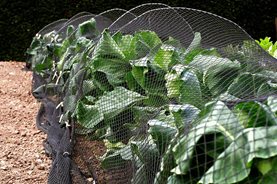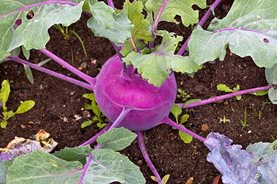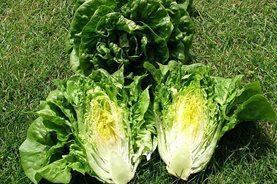How to acquire allotment abundance
Many gardeners contact the advice team this season with tales of woe about why they have not been able to sow and plant their veg garden or allotment
Naturally
I grieve for their loss of one of the best growing seasons for years,
experiencing dearth when they should be experiencing abundance. However,
this does not last long as late July onwards
is a very important time to sow crops for next year and, if the autumn
is kind, for October and November, so these horticultural miscreants
have a good opportunity to make amends.
 Spring cabbage
is a luscious fresh food for March onwards, and will make sweet little
cabbages for June if you let it. Here at Wisley we aim to sow in early
August in a seedbed or module tray and plant out in September or
October. You can gather alternate plants as suggested for spinach below.
Pigeons should be excluded with nets.
Spring cabbage
is a luscious fresh food for March onwards, and will make sweet little
cabbages for June if you let it. Here at Wisley we aim to sow in early
August in a seedbed or module tray and plant out in September or
October. You can gather alternate plants as suggested for spinach below.
Pigeons should be excluded with nets.
Salad onions can be sown in August to overwinter and be ready to gather from March in the south and April elsewhere. Covering with a cloche after sowing will keep the leaves dry and free of downy mildew that can be a problem on allotments, breaking out the following May to infect other onion crops.
Spinach tends to go to seed sown in summer, but sown in the first week of September it produces abundant leaves in April. By sowing and thinning to leave one plant every 15cm (6ins) you can harvest every other plant and leave the remainder to grow for later harvesting.
 Spinach
beet is an even easier option – a July sowing will produce abundant
leaves the following spring before going to seed in May. Pigeons relish
spinach beet, but find proper spinach not to their taste – too sour one
assumes!
Spinach
beet is an even easier option – a July sowing will produce abundant
leaves the following spring before going to seed in May. Pigeons relish
spinach beet, but find proper spinach not to their taste – too sour one
assumes!
In the south, at any rate, calabrese sown now can give a useful crop in October, but safer bets especially in northern areas are turnips and kohlrabi. These are mighty quick growing and delicious boiled and glazed, although microwaving is a very good alternative for gardeners pushed for time. Sown in September turnips won’t make roots but are useful greens for March and April even in cold areas where spring cabbage can fail.
 Spring salads can be enhanced by hardy lettuces
such as Winter Density sown in early September and thinned to 20cm
(8ins) apart in October. These lettuces have a hard life but this gives
them plenty of flavour and abundant ‘bite’ just when you need salads for
the first warm days of spring.
Spring salads can be enhanced by hardy lettuces
such as Winter Density sown in early September and thinned to 20cm
(8ins) apart in October. These lettuces have a hard life but this gives
them plenty of flavour and abundant ‘bite’ just when you need salads for
the first warm days of spring.
Timely emergence is important, so rake and stir the ground well to kill off slugs and weeds. Then a few days later, water freely in the evening and sow into moist soil the following morning.
 Spring cabbage
is a luscious fresh food for March onwards, and will make sweet little
cabbages for June if you let it. Here at Wisley we aim to sow in early
August in a seedbed or module tray and plant out in September or
October. You can gather alternate plants as suggested for spinach below.
Pigeons should be excluded with nets.
Spring cabbage
is a luscious fresh food for March onwards, and will make sweet little
cabbages for June if you let it. Here at Wisley we aim to sow in early
August in a seedbed or module tray and plant out in September or
October. You can gather alternate plants as suggested for spinach below.
Pigeons should be excluded with nets.Salad onions can be sown in August to overwinter and be ready to gather from March in the south and April elsewhere. Covering with a cloche after sowing will keep the leaves dry and free of downy mildew that can be a problem on allotments, breaking out the following May to infect other onion crops.
Spinach tends to go to seed sown in summer, but sown in the first week of September it produces abundant leaves in April. By sowing and thinning to leave one plant every 15cm (6ins) you can harvest every other plant and leave the remainder to grow for later harvesting.
 Spinach
beet is an even easier option – a July sowing will produce abundant
leaves the following spring before going to seed in May. Pigeons relish
spinach beet, but find proper spinach not to their taste – too sour one
assumes!
Spinach
beet is an even easier option – a July sowing will produce abundant
leaves the following spring before going to seed in May. Pigeons relish
spinach beet, but find proper spinach not to their taste – too sour one
assumes!In the south, at any rate, calabrese sown now can give a useful crop in October, but safer bets especially in northern areas are turnips and kohlrabi. These are mighty quick growing and delicious boiled and glazed, although microwaving is a very good alternative for gardeners pushed for time. Sown in September turnips won’t make roots but are useful greens for March and April even in cold areas where spring cabbage can fail.
 Spring salads can be enhanced by hardy lettuces
such as Winter Density sown in early September and thinned to 20cm
(8ins) apart in October. These lettuces have a hard life but this gives
them plenty of flavour and abundant ‘bite’ just when you need salads for
the first warm days of spring.
Spring salads can be enhanced by hardy lettuces
such as Winter Density sown in early September and thinned to 20cm
(8ins) apart in October. These lettuces have a hard life but this gives
them plenty of flavour and abundant ‘bite’ just when you need salads for
the first warm days of spring.Timely emergence is important, so rake and stir the ground well to kill off slugs and weeds. Then a few days later, water freely in the evening and sow into moist soil the following morning.

No comments:
Post a Comment